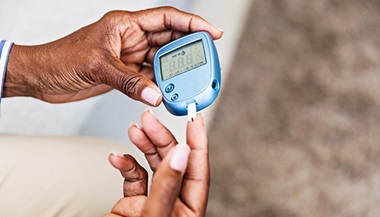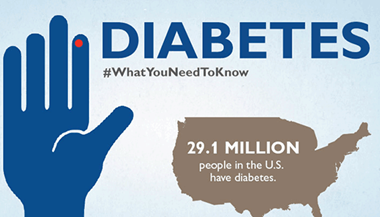Hypoglycemia: Nocturnal
Low blood glucose at night
When blood glucose levels fall below 70 mg/dl while sleeping at night, the person experiences a condition called nocturnal hypoglycemia.
Studies suggest that almost half of all episodes of low blood glucose — and more than half of all severe episodes — occur at night during sleep.
Nocturnal hypoglycemia can be potentially dangerous. The good news is that this condition can be prevented with careful planning and by training roommates and partners to recognize and treat the condition.
Who's at risk?
Nocturnal hypoglycemia can affect people who:
-
Skip meals, particularly dinner
-
Exercise before bedtime
-
Drink alcohol before bedtime
-
Have infections
People who have previously experienced nocturnal hypoglycemia:
-
Take a type of insulin at dinner known as NPH, which becomes most effective six to eight hours after each dose
What are the warning signs?
Call your doctor if you or your partner notice the following symptoms at night:
-
Restless, irritable sleep
-
Hot, clammy or sweaty skin
-
Trembling or shaking
-
Changes in breathing (suddenly breathing fast or slowly)
-
Nightmares, sometimes rousing the person from sleep
-
Racing heartbeat
Doctors are most concerned about people who sleep through these symptoms without noticing them.
What should I do if this happens?
People and their partners or roommates should learn to recognize the signs of nighttime hypoglycemia. Be prepared! Ask your doctor for an emergency glucagon kit. This kit contains a fast-acting medication that can be injected if the person can’t be woken up. Store the kit in a bedside drawer for easy access.
DO NOT PUT ANYTHING INTO A PERSON'S MOUTH IF THEY ARE ASLEEP OR CANNOT SIT UP.
-
If the person cannot be woken: If there is no emergency glucagon kit, call 911. If the person has a glucagon kit, the partner or roommate should follow the instructions to fill the syringe and inject the medicine. Once fully awake, he/she should eat a meal and check their blood glucose every few hours using a home test kit. After giving the injection, the person’s doctor should be notified.
-
If the person can be woken up and sit without support: They should be given a fast-acting glucose source. Good options include hard candy, fruit juice or glucose paste or tablets, which can be purchased at most pharmacies. Once the person is fully awake, they should eat a meal and check their blood glucose every few hours using a home test kit.
Always follow up with the doctor
It is very important to call your doctor as soon as possible after experiencing nocturnal hypoglycemia. The patient and doctor should try to figure out what caused the episode and how to prevent it from happening again.
Often the doctor will suggest:
-
Changing the dose or timing of insulin or other medications
-
Setting an alarm for the early morning so that the patient can test their blood glucose levels and determine how often the episodes occur
-
Having the person wear a continuous glucose monitor that checks blood glucose every five minutes with an alarm that wakes the patient from sleep if levels start to drop too low. This option is usually reserved for patients who experience frequent or severe nocturnal hypoglycemia





